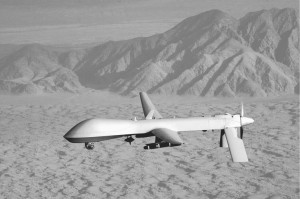
I was part of a delegation to Pakistan in October 2012 to address the issue of United States drone warfare. Several thousand Pakistanis, including small children, have been killed by U.S. drones and many others have been critically injured. During just one day of our visit, 18 people were killed by drones.
We heard from individuals whose family members had been killed. One of them, a bereaved Pakistani journalist summed up his view of the situation by saying, “The blood shed [sic] of Muslim people has no value.” He told us of the drone strike that destroyed his house, killing his 18-year-old son, his younger brother, and a stonemason who was in the village to work on the mosque. His son, a recent high school graduate, was working at his school because he wanted to encourage the community to value education. His brother had a master’s in English literature and had taught for eight years, trying to convey to students that education was more powerful than weapons. He left a grief-stricken wife and a two-year-old son.
We heard about the terror caused by the constant presence of drones in some areas. Pakistanis are afraid to attend gatherings like weddings, funerals, or business meetings. They know they will probably all be killed if their houses are targeted, and believe that the U.S. Central Intelligence Agency views all young and middle-aged men as potential targets. (A new counter-terrorism manual for targeted killing operations explicitly exempts the CIA from having to follow the rules in its campaign of drone strikes in Pakistan for at least a year.)
When the Deputy Chief of U.S. Mission, Richard Hoagland, spoke with us, he maintained that very few civilians had been killed by drones. When he was asked about the second-wave and even multiple strikes that have been killing and wounding many rescuers, he stated that in recent years, there have never been deliberate strikes against rescuers. We urged him to investigate and provide a public report.
The day after a candlelight vigil with young people, we traveled toward the targeted areas of Waziristan with Imran Khan’s large peace caravan. We passed many people who expressed support by waving and giving the peace sign. At a rally, we stood on the stage with our banner “Stop Killer Drones.” Code Pink’s Medea Benjamin spoke; the crowd called out repeatedly, “Welcome to you! We want peace!”
Prior to the trip, the U.S. State Department had issued a warning that U.S. citizens would be in danger if they traveled to Pakistan. Our delegation was given a very warm welcome. We were showered with rose petals and given bouquets at the airport. Throughout the trip, we were warmly received and shown generous hospitality in spite of the country’s poverty. People understood that we believe their lives are sacred and that we are committed to working for peace and an end to the evil of drone warfare. It may be a long and difficult struggle, as the U.S. government seems intent on continuing the use of drone warfare in order to help control its access to natural resources.



Comments on Friendsjournal.org may be used in the Forum of the print magazine and may be edited for length and clarity.